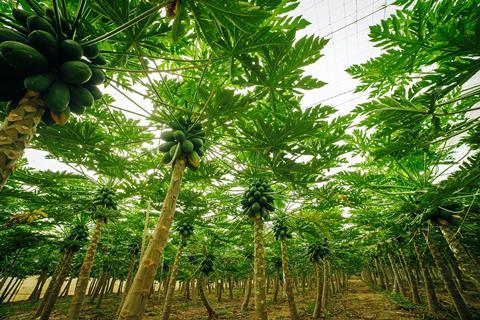The company is positioning itself as a supplier of sustainable, high-quality and competitively priced papayas for the European market

Europe currently imports almost one-third of all the papayas grown in the world, but accounts for less than 5 per cent of global production. Jorge Ignacio Brotóns, commercial director of Bonnysa, explains why the company is seizing the opportunity to offer a more sustainable alternative.
Jorge, what plans do you have to develop your papaya programme in 2024?
Jorge Brotóns: Papaya is a key product for Bonnysa. We pioneered its production in the Canary Islands and have adapted our cultivation techniques to suit the subtropical conditions on Tenerife. Our papayas have exceptional quality, an intense flavour and are available through 12 months of the year. What’s more we guarantee a 70 per cent reduction in carbon footprint compared to papayas imported from overseas – an added value that few suppliers can offer. Supermarkets want to focus on proximity and Bonnysa allows them to source a sustainable, premium product, ripened on the tree, at a competitive price.
Right now we are exploring new marketing opportunities, namely the creation of a brand to position our papayas as the trusted option for European consumers.
Tell us a bit more about the types of papayas you grow.
JB: We work with the Honey variety, which is known for distinctive organoleptic qualities, particularly its aroma and sweetness. Unlike other varieties, this one is highly appreciated by consumers who try it for the first time. We grow them all year round, with bigger volumes coming on stream between December and May.
We try to stay up to date with all the varietal developments that emerge so that we can always give the consumer the best options in terms of flavour, calibre and general appearance.
Is papaya consumption increasing in Spain and in the rest of Europe? Is Bonnysa carrying out any production campaign this year for papaya?
JB: Papaya is not as well-known as other tropical fruits that already have a place in the shopping basket. Little by little, consumers are becoming more aware of the fruit’s nutritional benefits, as well as its versatility as a product that can be consumed fresh and as part of a recipe.
Per capita consumption is growing slowly, but there’s no doubt it remains a niche product so we have to continue working trying to explain its benefits and qualities to the consumer.
At Bonnysa, we have modified our packaging and communication strategy to better convey that this is a product grown in Spain, and as such is a more sustainable alternative than papayas imported from more distant countries.
Do you think that over time, Spanish papayas will replace a larger proportion of imported papaya in the European market?
JB: Absolutely. The benefits are clear: we offer a product that exceeds expectations in terms of flavour, is competitive in terms of quality and price, 100 per cent European and therefore more sustainable. With all these attributes, we expect papaya sales to grow strongly in the coming years.



